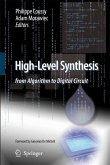Tremendous achievements in the area of semiconductor electronics turn - croelectronics into nanoelectronics. Actually, we observe a real technical boom connected with achievements in nanoelectronics. It results in devel- mentofverycomplexintegratedcircuits,particularlythe?eldprogrammable logic devices (FPLD). Up-to-day FPLD chips are so huge, that it is enough only one chip to implement a really complex digital system including a da- path and a control unit. Because of the extreme complexity of modern - crochips, it is very important to develop e?ective design methods oriented on particular properties of logic elements. The development of digital s- tems with use of FPLD microchips is not possible without use of di?erent hardware description languages(HDL), such as VHDL and Verilog. Di?erent computer-aided design tools (CAD) are wide used to develop digital system hardware. As majorityof researchespoint out, the design processis nowvery similar to the process of program development. It allows a researcher to pay more attention to some speci?c problems, where there are no standard f- mal methods of their solution. But application of all these achievements does not guaranteeper sedevelopmentof some competitiveelectronic product,- pecially in the acceptable time-to-market. This problem solution is possible only if a researcher possesses fundamental knowledge of a design process and knows exactly the mode of operation of industrial CAD tools in use. As it is known, any digital system can be represented as a composition of a da- path and a control unit.
Dieser Download kann aus rechtlichen Gründen nur mit Rechnungsadresse in A, B, BG, CY, CZ, D, DK, EW, E, FIN, F, GR, HR, H, IRL, I, LT, L, LR, M, NL, PL, P, R, S, SLO, SK ausgeliefert werden.









